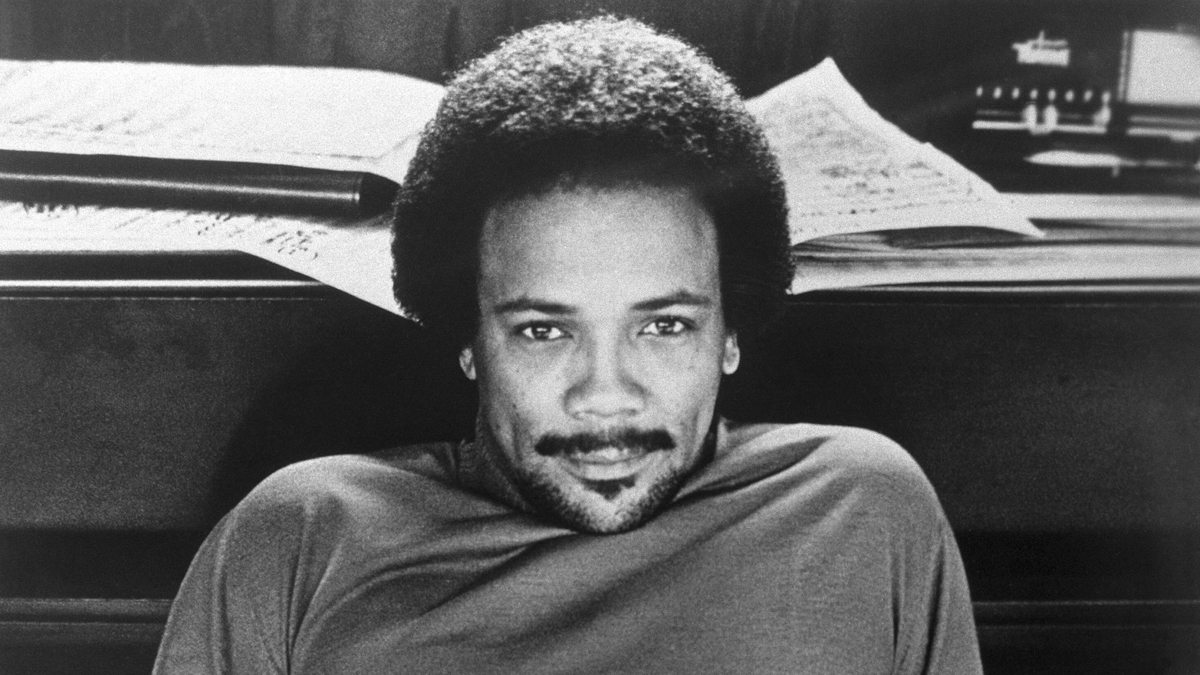5 Quincy Jones songs producers need to hear
In tribute to Quincy Jones, who has passed away aged 91 it’s time to take some tips from the master

Quincy Jones, a genuine music titan, has died, aged 91. Here, in tribute, we present our impossible pick from a might body of work...

Quincy Jones: “My proudest achievement? It would be like having to name my favourite child"
It’s hard to put into words the sheer range, quality and volume of Quincy Jones’ output. From early moves as an in-demand trumpeter, he was soon creating his own arrangements and then scoring movie soundtracks.
From there came his legendary work as a music producer, which included helming the biggest-selling album of all time, Michael Jackson’s Thriller.
We’ve distilled an incredible 70-odd years in the music business into just five of the great man’s production moves below, along with what we reckon is an essential and diverse grab bag of further listening yet. Dig deep
1. Michael Jackson – Don’t Stop Til You Get Enough
You know, I was wondering, you know, if… if you could keep on, because, the force… it’s got a lot of power and… it makes me feel like… it makes me feel like… OOOOH!
OK, let’s get this party started with this absolute tidal wave of a track. Trust us: picking just one of MJ’s Jones-produced hits for this list was a nightmare (Beat It, Billie Jean, Thriller… on and on they go...) but Don’t Stop clinches it for so many reasons.
Firstly, it’s the first song MJ wrote solo and his first single from his first solo album and - as the way he rolls his sleeves at 0:21 in the video makes clear - this guy means business. Next, it’s the super-fresh combo of Quincy Jones, MJ and the secret weapon that is mix engineer Bruce Swedien who are all - perhaps unwittingly at the time - at the top of their game. Jones, fresh from scoring The Wiz soundtrack (starring Jackson as the cowardly lion) was asked by MJ if he knew any good producers who might like to tackle his first solo cut. The rest is history.
Get the MusicRadar Newsletter
Want all the hottest music and gear news, reviews, deals, features and more, direct to your inbox? Sign up here.
Quincy imbues Don’t Stop with a multitude of musical bombs, from the ambient tin can percussion to the loud, resonant post-bridge toms, to the looming glimmers of dark strings and the party in the background during the break. And let’s not forget that Jackson sings the whole song in a never-repeated falsetto; think about it - it doesn’t even sound like MJ!
Finally, the whole business is perfectly captured by Swedien using ‘the Acusonic recording process’. This wasn’t some magical new studio ‘black box’ as was thought at the time, but merely the way Swedien used SMPTE code to synchronise the 24-track tape machines used to record the track.
Swedien became obsessed with the fact that the more the analogue tape was played the duller the transients on it became, convinced that he could hear the tape getting worse each time he played it. As a result, he took to recording the rhythm section of the band onto their own 24-track and then putting this way until the final mix, whereupon this fresh, never-played take would be flown in, in sync with the rest of the track and as fresh as the moment it was recorded.
Whether you believe it or not, there’s no denying that the drums and bass all through Off The Wall AND Thriller really are second to none. (If you’re yet to partake, do take the time to grab the kick and snare from the opening moments of Billie Jean - you can thank us later.)
And do take do take a moment to revel in the closing passage of Don’t Stop in its full album form, as Swedien slowly fades that awesome rhythm section at 5:30, melting things away to reveal the airy tapping percussion and relentless guitar and Clav parts that have secretly been powering the track for its duration. Perfection.
2. Lesley Gore - You Don’t Own Me
Let’s wind it all the way back to 1963. It’s easy to forget that the seminal, original recording of much covered, dawn-of-the-swinging-sixties mega anthem It’s My Party (by Lesely Gore) was, in fact, produced by Quincy Jones - his very first hit single.
Through a tortuous mix of good fortune, mistakes and sheer grit it’s the version by the plucked-from-obscurity 16-year old Gore with Jones that made history, while recorded (but put-on-hold) versions by (megastar) Helen Shapiro and The Crystals (produced by Phil Spector) were beaten to the punch after Jones was tipped off about Spector’s imminent Crystals release and rushed home from a gig to press 100 copies and get it out first.
However, such is the familiarity of It’s My Party and hastiness of cash-in album I’ll Cry If I Want To (where SIX of the album’s 12 tracks feature the word ‘cry’ in their title, It’s My Party - a song totally about crying - NOT being one of them) that we’re skirting Gore’s debut for her more mature, sonically superior second wind.
You Don’t Own Me - from the older, wiser, now 17-year-old Gore - is a careful, dangerous track, with a soaring string-powered chorus and a vocal drenched in tape delay (where the vocal was recorded off to a second tape machine only to be spun back in a fraction of a second behind the original) and spring reverb (where the sound was literally played inside a box containing - yup - a mic’d-up spring).
Its hands-off, feminist themes were, at the time, as bold and striking as the track’s production. Do take the time to listen on headphones (and likewise to It’s My Party) in order to witness a mix at the ‘dawn of stereo’, where engineers, flush with the new technology, would push entire drum kits or bass hard left or right to give those TWO speakers a thorough workout.
The result is an arresting, genuinely hi-tech, wide sound that’s well worth a revisit, we reckon. Next time your mix is sounding too cluttered, why not get a little heavy-handed with that pan control?
Unfortunately, You Don’t Own me failed to top number one It’s My Party, stalling at number two behind The Beatles’ (let’s face it, hugely deserving) I Wanna Hold Your Hand. Sadly, it was the promising Gore’s last top 10 single.
3. Donna Summer - Love Is In Control (Finger On The Trigger)

What can we say? Just when you think you’ve got the measure of this light-stepper the bass drops at 0:57 and things get too damn funky. Yes, the bass is too loud - a mix of live bass, synth bass and deep, mumbled vocoder - but with a killer combo sound like that you can’t blame legendary mix engineer Bruce Swedien for giving that fader an extra nudge.
The track was the lead single from Summer’s 1982 self-titled album which - in another space and time - could have become the world’s biggest album… and it all starts with a picky label boss axing a legacy…
Summer had moved to Geffen records in 1980 and after an only fair performance of her first album there - The Wanderer - all eyes were on her for the sequel. Unfortunately, label owner David Geffen hated the meandering proposed follow up, I’m A Rainbow, and ordered it scrapped, sending Summer into the studio with the hot-from-Off The Wall, Jones, who - ever the businessman - tucked this in immediately before starting on the all-conquering Thriller.
The switch effectively ended Summer’s relationship with producers Georgio Moroder and Pete Bellotte who had produced NINE hit albums for her previously (including minting the electronic classic I Feel Love).
This track (and the rest of the Donna Summer album) is, therefore, the sound of Jones shifting gear and warming up for Thriller which - of course - would go on to become the biggest-selling album of all time, and many of the tracks on board share direct DNA with Jackson’s biggest hits.
Firstly, it’s Jones’ first airing of his New England Digital Synclavier synth, credited on the sleeve notes (which would go on to provide those clanging chimes at the start of Beat It), plus the track was co-written by Rod Temperton who’d penned Rock With You and Off The Wall for MJ, and would later co-write title track Thriller.
Love Is In Control also served as a practice run for the similar, vocoder-loving PYT for MJ. And if you close your eyes you can practically hear MJ’s on vocals here… complete with “Hoo!”s and “Oh Yeah!”s… But most of all it features a stripped back, funky, spacious sound that gives every element room to breathe while still knocking the wind out of you - basically what was to become the prototypical MJ sound.
Love Is In Control reached an under-rated number 10 stateside and a similarly undeserving 18 in the UK (album just 20 and 13,) but if you’ve ever wished MJ had made an album between OTW and Thriller then Donna Summer (also featuring silver medal single State of Independence) may just be your dream come true.
BTW, if this track does grab you like it should, DO check out 2013’s pure dynamite Chromeo & Oliver remix.
4. The Brothers Johnson - Strawberry Letter 23
What a classic and what a curious route to hitsville. The Brothers Johnson were brothers George "Lightnin' Licks" Johnson (guitar) and Louis E "Thunder Thumbs" Johnson (bass), who neatly slid the gear changes from R’n’B, through funk, into disco at the end of the ‘70s. Do check out their equally magnificent (R’n’B, 1966) I’ll Be Good To You and Stomp! (Disco, 1980) both also produced by Jones.
Despite forever being etched in the mind as a classic all The Brothers’ own, it is in fact a cover version. George Johnson was at the time dating one of the cousins of overlooked artist Shuggie Otis, whose 1971 Freedom Flight featured the folky, trippy original that was never released as a single. Hearing its potential, Johnson played it to Jones and the trio set about reworking it.
Lyrically, Letter 23 is an intriguing concept. It concerns the numbered exchanges of love letters between the singer and his lover and makes reference to Strawberry Letter 22, the most recent (numbered) missive the singer has received. Strawberry Letter 23, therefore, is the song itself - a love letter being produced in song form and, therefore - at the time of being performed - yet to arrive as letter number 23. As a result, the number 23 is never mentioned in the song.
Jones and The Brothers imbue the slightly psychedelic original with a loping, funky strut that’s pure ‘77 and “Thunder Thumbs'' relishes the opportunity to get wet and wild with the bass part. Next time you’re on auto-pilot and reaching for that quantise button, spare a thought for tracks like this one that sound freakin’ perfect on account of not being lined up to the pixel…
While the bass and groove run free, The Brothers couldn’t top the jazz arpeggio guitar solo of Otis’ 1971 original. However, recreating it proved a little beyond the ken of “Lightnin’ Licks”… Instead it’s legendary session guitarist Lee Ritenour who provides it, with stunning accuracy of timing and tone. Do take the time to compare the original solo at 2:22 here and Ritenour’s flawless remake for The Brothers at 2:25.
The hit single that never was for Shuggie Otis reached number 5 in the States for The Brothers and - needless to say - the 7-inch was released in a limited edition strawberry scented sleeve.
5. Quincy Jones - Ai No Corrida
If you’re a stranger to Jones’ 1981 album The Dude, then go on, treat yourself… we’ll meet you back here in 41 minutes…
The Dude blissfully fuses the jazz, funk and pop of Jones’ life's work to date, and features collaborations with countless world-class musicians and vocalists such as James Ingram and Stevie Wonder. The liner notes even feature a credit for handclaps (Lenny Castro).
Lead track (and hit single) Ai No Corrida is actually a cover version, the original being by Ian Dury and The Blockheads’ keyboardist Chas Jankel, but it was Jones’ funkier take - fusing funk, jazz and salsa - that was the global hit. The title comes from the scandalous 1976 French/Japanese film In The Realm Of The Senses (Ai no Korîda in Japanese - meaning ‘Bullfight of Love’) which is a tortured tale of lovers who experiment with erotic asphixiation before taking it to the next level with the female protagonist murdering her lover and cutting off his penis and testicles. That gives the lyric - “You see girl, you thrill me, half kill me” - an altogether new perspective…
Similarly, Something Special and Razzamatazz - penned by Rod Temperton - are jazz/funk/disco gems, and the next time you’re programming a bass part, take influence from the amazing Betcha Wouldn’t Hurt Me where the bassline - yup, provided by Louis E "Thunder Thumbs" Johnson - threatens to outclass Patti Austin’s excellent vocal.
Extended remix: We’ve gotta be starting something… don’t let our essential further listening slip out of your life
Frank Sinatra – Fly Me To The Moon
Yup. Jones did the arrangements on Sinatra’s classic It Might As Well Be Swing album. Featuring Count Basie and his orchestra, his legendary Fly Me To The Moon is its lead track. Impressed? So you should be.
OK. Let’s go back to the Jackson well for one of our favourite recording anecdotes.
By now you probably know that the track features a blistering solo by famous jazz organist Jimmy Smith. Dropping at 2:29, it magically segues into a similarly explosive synth solo from Greg Phillinganes. However, so keen were Jackson and Jones to wring every nugget of gold out of Smith’s badass performance that they even mic’d him up to capture his breathing and the sound of his fingers on the keys as he played.
Also, think about that for a moment. Bad has an organ solo? Genius.
Miles Davis and Quincy Jones - Miles & Quincy Live at Montreux
If you’ve ever tried to step into Miles but have found his Bitches Brew a little too potent, try this Davis & Jones one-off live collaboration - a perfect, palatable cocktail that hits all the right notes in the right order. It was recorded in 1991, just three months before Davis’ passing.
George Benson - Give Me The Night
Another near miss from our top five. Once again produced by Jones, penned by Rod Temperton. Worth noting that while Benson himself is a guitarist of some note, familiar legend Lee Ritenour also plays on this track.
USA For Africa - We Are The World
OK. Not a classic, but actually Jones’ biggest hit. Recorded in a mammoth 12-hour session and co-written by Michael Jackson (lyrics) and Lionel Richie (music), with the band from Thriller taking care of the track, the project raised over $68 million dollars for famine relief in 1985.
However, despite shifting over 20 million copies, participant Cyndi Lauper described the song as sounding ‘like a Pepsi commercial’, and she has a point. Madonna famously wasn’t invited to contribute but - let’s set the record straight - Prince was and WAS in town to pick up ‘favourite pop/rock’ and ‘favourite soul album’ for Purple Rain at the American Music Awards that night… but simply didn’t show. His lines went to Huey Lewis.
Quincy Jones - They Call Me Mr Tibbs OST
Of all of Jones’ soundtrack work (The Hot Rock, The Heist, In The Heat Of The Night…) we’re going for the funky state-of-the-art (for 1970) organ-heavy They Call Me Mr Tibbs.
D&B producers: we suggest you listen to the track Hot Poppadaddy. Try 15:01 in our link…
James Ingram & Michael McDonald – Yah Mo B There
Produced by Jones, co-written by Temperton, another (LinnDrum heavy) modern classic that just skirted our top five. But where does that title come from?…
Quincy & Herbie’s Rhodes & Fairlight Jam
OK. Not a track at all but one of our favourite videos. Watch Herbie Hancock show a cognac-sipping Jones his spanking new Fairlight sampler before engaging in an impromptu jam on a Rhodes Chroma. THIS is what YouTube was made for.
Daniel Griffiths is a veteran journalist who has worked on some of the biggest entertainment, tech and home brands in the world. He's interviewed countless big names, and covered countless new releases in the fields of music, videogames, movies, tech, gadgets, home improvement, self build, interiors and garden design. He’s the ex-Editor of Future Music and ex-Group Editor-in-Chief of Electronic Musician, Guitarist, Guitar World, Computer Music and more. He renovates property and writes for MusicRadar.com.
"I said, “What’s that?” and they said, “It’s what Quincy Jones and Bruce Swedien use on all the Michael Jackson records": Steve Levine reminisces on 50 years in the industry and where it’s heading next
“I’m looking forward to breaking it in on stage”: Mustard will be headlining at Coachella tonight with a very exclusive Native Instruments Maschine MK3, and there’s custom yellow Kontrol S49 MIDI keyboard, too














